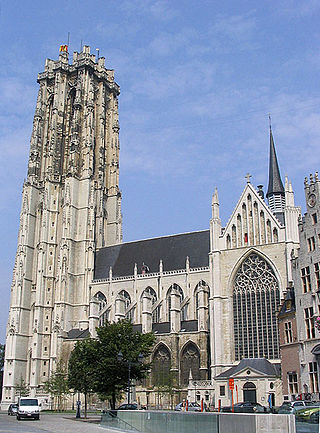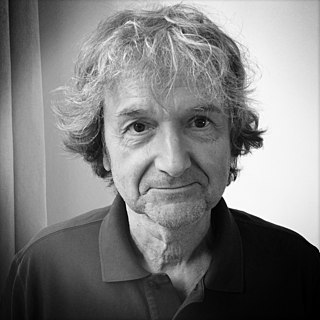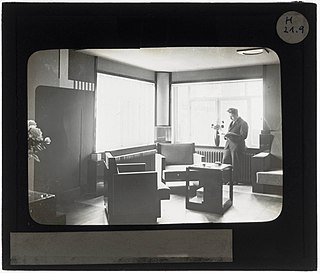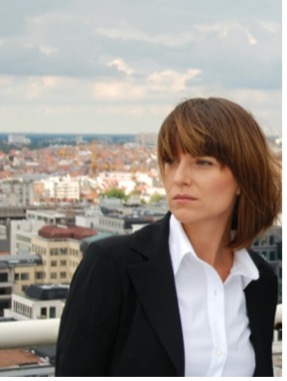Bob Van Reeth | |
|---|---|
 | |
| Born | February 26, 1943 |
| Nationality | Belgian |
| Occupation | Architect |
Bob Van Reeth (Temse, 26 February 1943), who usually signs as bOb Van Reeth, is a Belgian architect.
Bob Van Reeth | |
|---|---|
 | |
| Born | February 26, 1943 |
| Nationality | Belgian |
| Occupation | Architect |
Bob Van Reeth (Temse, 26 February 1943), who usually signs as bOb Van Reeth, is a Belgian architect.
Bob Van Reeth started working as an architect in 1965 with designing buildings in Mechelen and Kalmthout. In 1972, he became a teacher at the Nationaal Hoger Instituut voor Bouwkunst (The National Higher Institute for Architecture) in Antwerp. The same year, he started the group Krokus with Jean-Paul Laenen and Marcel Smets. The group worked on the restoration of the old centre of Mechelen.
In the 1980s, Van Reeth designed a new building for the Onze-Lieve-Vrouwecollege in Antwerp. Later buildings include in 2007 a new wing for the Westvleteren Abbey, and the black-and-white Huis Van Roosmalen facing the Scheldt in Antwerp. [1] Close by stands the Zuiderterras, a grand café on the quay. [2] He also leads the company AWG (Architect Work Group) Architecten, which won the architectural concours for the design of a memorial and documentation centre about the Holocaust in Mechelen. [3]
In January 1998, Van Reeth became the first Flemish Government Architect (Vlaams Bouwmeester), a function he held until 1 June 2005 when Marcel Smets succeeded him. [4]

Mechelen is a city and municipality in the province of Antwerp in the Flemish Region of Belgium. The municipality comprises the city of Mechelen proper, some quarters at its outskirts, the hamlets of Nekkerspoel (adjacent) and Battel, as well as the villages of Walem, Heffen, Leest, Hombeek, and Muizen. The Dyle flows through the city, hence it is often referred to as the Dijlestad.
Michiel Coxie the Elder, Michiel Coxcie the Elder or Michiel van Coxcie, Latinised name Coxius, was a Flemish painter of altarpieces and portraits, a draughtsman and a designer of stained-glass windows, tapestries and prints. He worked for patrons in the principal cities of Flanders. He became the court painter to successively Emperor Charles V and King Philip II of Spain.

Hendrick de Keyser was a Dutch sculptor, merchant in Belgium bluestone, and architect who was instrumental in establishing a late Renaissance form of Mannerism changing into Baroque. Most of his works appeared in Amsterdam, some elsewhere in the Dutch Republic. He was the father of Pieter and Thomas de Keyser and Willem, and the uncle of Huybert de Keyser, who became his apprentices and all involved in building, decoration and architecture.
Keldermans is a family of artists, originating from Mechelen. The members of the family were mostly architects working in the Brabantine Gothic style. As the most important architects of their time in the Netherlands, they defined the Brabantine Gothic style, and their works can still be seen today in cities like Mechelen, Brussels, Antwerp, Ghent, Lier, Middelburg and Gouda. Anthonis II and Rombout II were court architects for Charles V. Laurens II, last in the line, was influenced by Renaissance architecture and marked the end of the Gothic period in this region. The Keldermans family became known for the design and construction of the large tower of St Rumbold's Cathedral in Mechelen. Jan II qualifies most as the designer, the architect and the most important master builder. However, he would not see the start of the works himself and the first stone was therefore laid under the supervision of his son Andries. Other members of the Keldermans family who successively directed the works are Anthonis I, Anthonis II, Rombout II and Laurens II.

Antwerpen-Centraal railway station, officially Antwerpen-Centraal, is the main railway station in Antwerp, Belgium. The station is operated by the National Railway Company of Belgium (NMBS/SNCB).
The Oosterweel Link is a construction project first proposed in 1996, intended to complete the R1 Antwerp Ring Road in Antwerp, Belgium. The firm Antwerp Mobility Management Company, is the Flemish Government controlled organisation assigned responsibility for the project. The Oosterweel link will connect the Expressweg (E34) near Blokkersdijk via a toll tunnel underneath the Scheldt, leading to a dual-layered tunnel under the Albert Canal and connecting with the Antwerp Ring Road at Merksem and Deurne.

Jacob Franquart or Jacob Franckaert the Younger was a Flemish architect, painter, print artist, draftsman, military engineer and poet. He is known for his altarpieces and publications on contemporary Italian architecture. He was employed by the court of the Archdukes Albert and Isabella in Brussels as a painter and architect. He was responsible for the design of ephemeral decorations and structure for important occasions at the court such as funerals. As an architect and decorator, he introduced the Baroque in the buildings of the Habsburg Netherlands. His style is sometimes referred to as the Italo-Flemish style and became very popular in Flanders in the 17th century. Only a few paintings are attributed to him.

Lucas Faydherbe was a Flemish sculptor and architect who played a major role in the development of the High Baroque in the Southern Netherlands.

Wenceslas Cobergher, sometimes called Wenzel Coebergher, was a Flemish Renaissance architect, engineer, painter, antiquarian, numismatist and economist. Faded somewhat into the background as a painter, he is chiefly remembered today as the man responsible for the draining of the Moëres on the Franco-Belgian border. He is also one of the fathers of the Flemish Baroque style of architecture in the Southern Netherlands.

Cornelis Huysmans was a Flemish landscape painter who was active in Antwerp, Brussels and Mechelen. Huysmans held a foremost position in Flemish landscape painting in the late 17th and early 18th century and was particularly known for his pseudo-Italianate landscapes with mountains in the background, which show the influence of Nicolas Poussin and Jacques d'Arthois.

Anthonis van Obbergen was a Flemish architect and fortifications engineer. After studying masonry in Mechelen and completing a tour to study fortification work in Germany, he initially gained experience working on the fortifications of Antwerp (1567–71). He later worked in Denmark and Poland where he designed fortifications as well as civilian homes.

Renaat Braem was a leading Belgian architect and urban planner in the latter half of the twentieth century.

Brabantine Gothic, occasionally called Brabantian Gothic, is a significant variant of Gothic architecture that is typical for the Low Countries. It surfaced in the first half of the 14th century at St. Rumbold's Cathedral in the city of Mechelen.
This article details events from the year 2005 in Belgium. Major events include the holding of the Junior Eurovision Song Contest in Belgium, and the appointment of Belgium's first female rabbi.

Johannes van Mildert or Hans van Mildert was a Flemish sculptor, who is best known for his baroque sculptures found in many Belgian and Dutch churches. Van Mildert played an important role in the development of the design of Flemish Baroque religious furniture.

Jan Vanriet, real name Jan Louis Lucien Vanriet, is a Belgian (Flemish) painter and poet.
The role of Flemish Government Architect was established in 1998 under Minister-President of Flanders Van den Brande to develop Architectural Design Policy in Flanders, Belgium.

Frans Smet-Verhas, born Frans Smet, was a Belgian architect. He was one of the principal designers to employ Art Nouveau in Antwerp at the beginning of the twentieth century.

Hubrecht (Huib) Hoste was a Belgian architect, designer and urban planner. He is considered the pioneer of modern architecture in Belgium.

Oana Bogdan is an architect with Belgian and Romanian nationality. Together with Leo Van Broeck, she founded the architectural firm Bogdan & Van Broeck. She is considered as an authority in the field of architecture and is much in demand as a jury member for architecture awards.